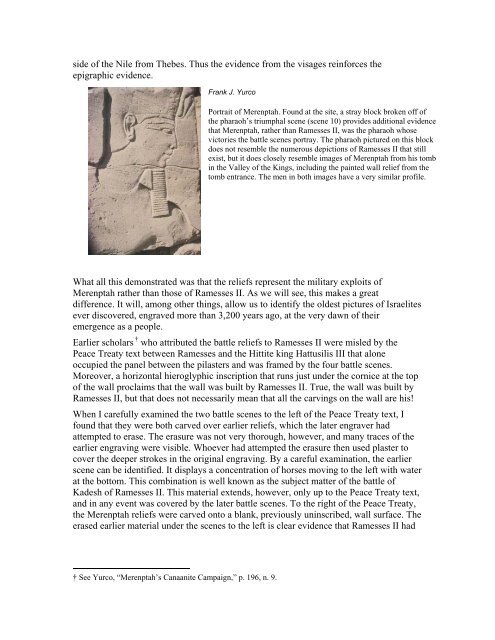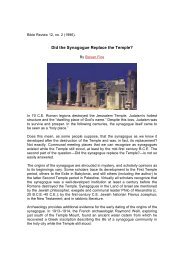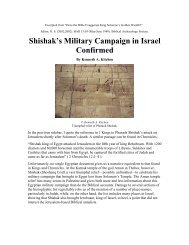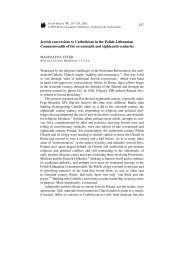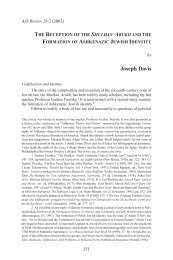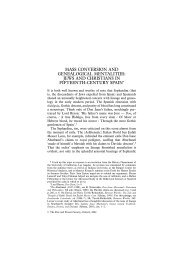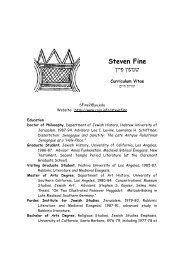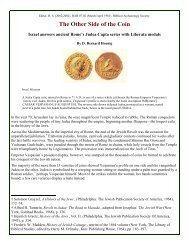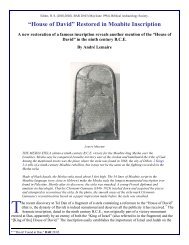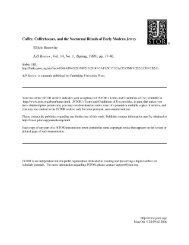3200-Year-Old Picture of Israelites Found in Egypt
3200-Year-Old Picture of Israelites Found in Egypt
3200-Year-Old Picture of Israelites Found in Egypt
You also want an ePaper? Increase the reach of your titles
YUMPU automatically turns print PDFs into web optimized ePapers that Google loves.
side <strong>of</strong> the Nile from Thebes. Thus the evidence from the visages re<strong>in</strong>forces the<br />
epigraphic evidence.<br />
Frank J. Yurco<br />
Portrait <strong>of</strong> Merenptah. <strong>Found</strong> at the site, a stray block broken <strong>of</strong>f <strong>of</strong><br />
the pharaoh’s triumphal scene (scene 10) provides additional evidence<br />
that Merenptah, rather than Ramesses II, was the pharaoh whose<br />
victories the battle scenes portray. The pharaoh pictured on this block<br />
does not resemble the numerous depictions <strong>of</strong> Ramesses II that still<br />
exist, but it does closely resemble images <strong>of</strong> Merenptah from his tomb<br />
<strong>in</strong> the Valley <strong>of</strong> the K<strong>in</strong>gs, <strong>in</strong>clud<strong>in</strong>g the pa<strong>in</strong>ted wall relief from the<br />
tomb entrance. The men <strong>in</strong> both images have a very similar pr<strong>of</strong>ile.<br />
What all this demonstrated was that the reliefs represent the military exploits <strong>of</strong><br />
Merenptah rather than those <strong>of</strong> Ramesses II. As we will see, this makes a great<br />
difference. It will, among other th<strong>in</strong>gs, allow us to identify the oldest pictures <strong>of</strong> <strong>Israelites</strong><br />
ever discovered, engraved more than 3,200 years ago, at the very dawn <strong>of</strong> their<br />
emergence as a people.<br />
Earlier scholars † who attributed the battle reliefs to Ramesses II were misled by the<br />
Peace Treaty text between Ramesses and the Hittite k<strong>in</strong>g Hattusilis III that alone<br />
occupied the panel between the pilasters and was framed by the four battle scenes.<br />
Moreover, a horizontal hieroglyphic <strong>in</strong>scription that runs just under the cornice at the top<br />
<strong>of</strong> the wall proclaims that the wall was built by Ramesses II. True, the wall was built by<br />
Ramesses II, but that does not necessarily mean that all the carv<strong>in</strong>gs on the wall are his!<br />
When I carefully exam<strong>in</strong>ed the two battle scenes to the left <strong>of</strong> the Peace Treaty text, I<br />
found that they were both carved over earlier reliefs, which the later engraver had<br />
attempted to erase. The erasure was not very thorough, however, and many traces <strong>of</strong> the<br />
earlier engrav<strong>in</strong>g were visible. Whoever had attempted the erasure then used plaster to<br />
cover the deeper strokes <strong>in</strong> the orig<strong>in</strong>al engrav<strong>in</strong>g. By a careful exam<strong>in</strong>ation, the earlier<br />
scene can be identified. It displays a concentration <strong>of</strong> horses mov<strong>in</strong>g to the left with water<br />
at the bottom. This comb<strong>in</strong>ation is well known as the subject matter <strong>of</strong> the battle <strong>of</strong><br />
Kadesh <strong>of</strong> Ramesses II. This material extends, however, only up to the Peace Treaty text,<br />
and <strong>in</strong> any event was covered by the later battle scenes. To the right <strong>of</strong> the Peace Treaty,<br />
the Merenptah reliefs were carved onto a blank, previously un<strong>in</strong>scribed, wall surface. The<br />
erased earlier material under the scenes to the left is clear evidence that Ramesses II had<br />
† See Yurco, “Merenptah’s Canaanite Campaign,” p. 196, n. 9.


